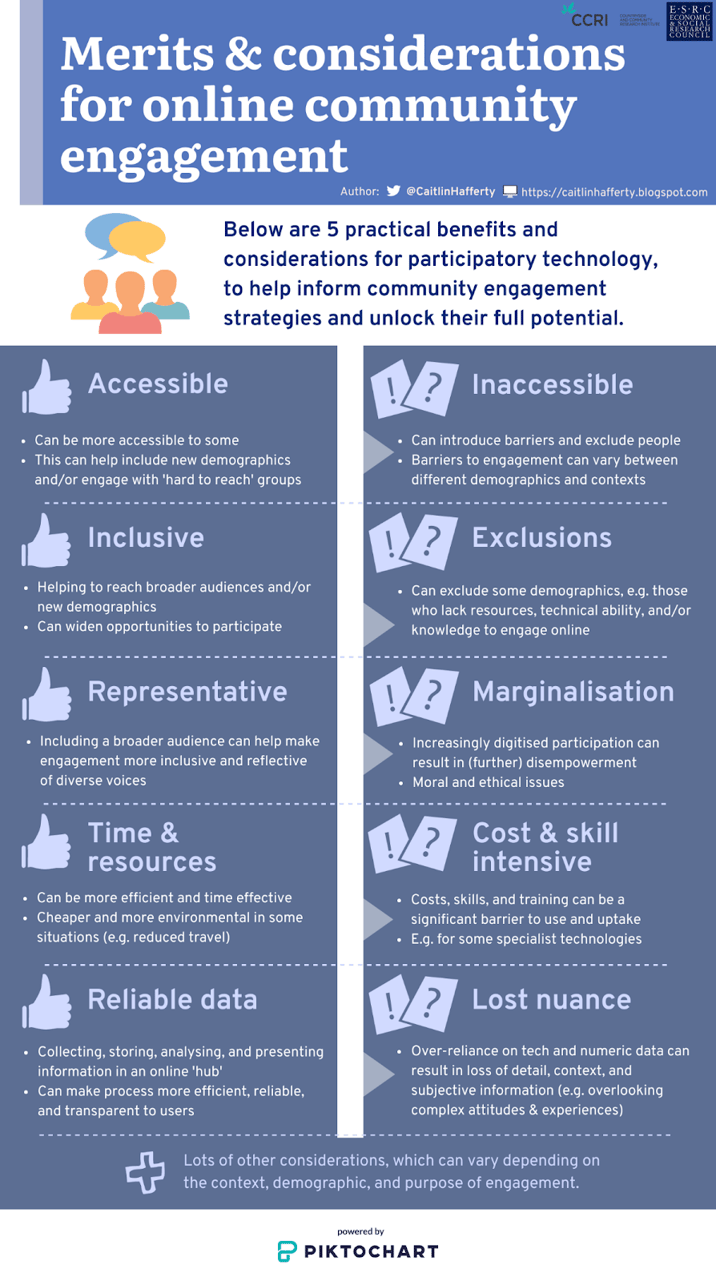Blending online and offline community engagement

By Caitlin Hafferty | 06/10/20 10:03
5 min read
Online and offline engagement both have their merits. Online has become increasingly popular, particularly during lockdown, but what is the future of community engagement? PhD researcher Caitlin Hafferty shares her thoughts and recommends that a combination of both in a flexible, adaptable, and blended approach, is the best way to unlock the full potential of community engagement.
Overview
- Community engagement can be complex. There are lots of online and offline tools available to enhance and facilitate participation.
- Different tools have different merits and considerations associated with their use. These can vary depending on the purpose and context they are used in.
- To help achieve a ‘best practice’ standard of community engagement in an increasingly digitised world, practitioners can adopt a 'blended approach' which embraces both online and offline techniques.
Guest Blog Post - Caitlin Hafferty
Numerous organisations and public bodies are thinking about how they can adopt a best practice approach to community engagement. However, when faced with a myriad of different online and offline tools, choosing the best approach can be a complex and daunting task. In this blog post I outline the merits and considerations for online and offline tools, and promote a flexible, adaptable, and 'blended approach’ for community engagement.
The way we conduct community engagement has changed significantly in 2020 – the Covid-19 pandemic has accelerated a shift in the way that we use and understand digital communication tools. This provides a unique opportunity to evaluate the way that we conduct community engagement.
We have witnessed a rapid increase in the use and uptake of digital tools, with groups and organisations realising new digital potentials for their engagement strategies. This has pushed the merits and considerations for different participatory technologies into the spotlight, sparking debates around what might be lost and/or gained by adopting more offline and remote approaches.
By looking at how groups and organisations have been using different online tools for engagement during lockdown, we can better understand the merits and considerations for different approaches.
Online vs offline tools for community engagement
Traditionally, town hall meetings (or other offline debates) were one of the main ways for local government, planners, and communities to meet face-to-face and share their opinions. While these approaches are valuable and meaningful in many contexts, the accelerated uptake of digital tools for engagement has led to increased debate regarding which approach leads to best practice standards of engagement.
Online (digital) tools
Lockdown has helped us understand how we can use different online tools, their merits, and what we need to consider when using them. This has led to an increased understanding of what is possible when digitising standard community engagement practices.
There are numerous online tools available for facilitating community engagement. In many situations, digital tools can help improve the accessibility of engagement processes, saves time and resources, and can produce a reliable ‘hub’ of data. The benefits of participatory technologies (and important considerations for their use) are covered in:
Thought pieces- Some very useful discussions in blogs by Grasshopper UK, Commonplace.
- Some practical examples of successfully engaging with communities online both before and during the pandemic.
- Catapult Future Cities has a news and opinion blog, which includes thoughts on planning and technology.
- Digital Leaders Week 2020 is hosting a variety of events on topics including technology, accessibility, and inclusion; smart cities; AI and data; and tech for good.
- The Royal Town Planning Institute (RTPI) held a webinar on virtual tools for co-design and community engagement.
- You can view this collection of articles (the International Journal of E-Planning Research), on the impact of Covid-19 on (urban) planning and community engagement and transformative recovery.
- Please see a list of academic articles for further reading at the end of this post.
- Planning for Children and Young People is an exciting project which looks at opportunities for the inclusion of children and young people in planning and design, including the use of digital mapping tools.
- Resolve Collective do some fantastic work on participatory and collaborative engagement with young people and under-represented groups, using a variety of different approaches.
While the merits of online tools for community engagement are relatively well established, the considerations for their use are perhaps not as widely discussed. The infographic below displays some merits of online engagement in a planning/decision-making context, and some important considerations for their use. When reading this, remember that different tools and approaches will work differently in different situations (a caveat which I’ll discuss later in this blog post).
 (Caitlin Hafferty 2020)
(Caitlin Hafferty 2020)Offline (face-to-face) tools
When considering the future of best practice community engagement, it might be tempting to imagine a 100% online approach where a single tool (or toolkit) is used as a blanket solution for all engagement processes. This need not be the case - while online tools have accelerated in prevalence and use, this is not to say that face-to-face (offline) approaches have decreased in significance.
Offline approaches can reap very important benefits which lose value when, and/or cannot be replicated, online. It’s important to remember that offline approaches are varied and are not just limited to traditional ‘town hall’ style consultations, with many creative approaches emerging in practice. Face-to-face engagement can also be augmented by technology, for example some forms of participatory mapping and gamified techniques (one great way of conducting ‘blended’ engagement).
In many contexts, offline engagement can improve the quality of participatory processes and the information that is produced to inform decisions. For example, in some situations they can be essential for building and maintaining meaningful relationships with people over time. This can help to develop trust and increased support for current and future projects, encouraging more informal and intimate communication which may not be possible online. Meaningful face-to-face approaches can also help capture, understand, and represent in-depth local knowledge, which is often essential for understanding complex issues and the context in which decision-making processes occur.
So, what’s the best tool to use?
There are merits and considerations for both online and offline engagement. It’s important to understand that there are no ‘right’ or ‘wrong’ tools to use for community engagement, providing that they are best suited to the purpose and context of engagement.
In addition, best practice engagement strategies do not need to be limited to one specific tool or technique, and instead it is recommended that engagement be viewed as a dynamic and flexible process. This means that multiple tools can be used, in isolation or in combination, at different stages in the engagement process – a blended approach to community engagement.
What is a blended approach?
While the merits of online and offline engagement are numerous, this doesn’t mean that these positive outcomes are always achieved. Sometimes engagement processes can fail or exacerbate issues within communities such as conflict, tensions, and distrust. This can cause costly delays to planning and decision-making processes, and even make it less likely that communities will engage in a positive manner in the future.
Engagement processes can be successful (or not) because they are complex and based on lots of different factors. These include the intended project outcomes, type of engagement and the context in which it is enacted, the demographic of people you are engaging with, and/or the time and resources available.
This helps us to understand why using a single tool or approach to engagement might not work in all situations – we shouldn’t need to follow a “one size fits all” or “either/or” approach to selecting online and offline tools. Instead, engagement practitioners can recognise the merits of both approaches and combine them to suit a given project or decision-making context. This involves appreciating that best practice engagement is one that takes an adaptable, flexible, and blended approach that involves consideration of which tools and approaches are best for specific projects, contexts, and/or audiences.
Top 3 tips for successfully running a blended approach
- Think about the purpose of the project (e.g. the intended outcomes for the project and wider community), and the context in which you are working. This includes understanding the local context of where you are conducting the engagement, the demographics of the community, and available resources.
- Use this understanding of purpose and context to help assess the available online and offline tools. This can help practitioners make an informed choice regarding which tools are best suited to the project and (local) context.
- Consider whether using a combination of online and offline tools will increase the likelihood that your engagement process will be successful, compared to using either/or methods in isolation. Here, engagement practitioners can take into account the merits and considerations associated with different techniques.
Author’s note:
Many of the ethics and principles of engagement discussed in this blog post have been informed by, and build upon, existing trans-disciplinary academic research. You can read more about this work in the following academic papers:
- Participation: The new tyranny?
- How does the context and design of participatory decision making processes affect their outcomes?
- Digital participatory platforms for co-production in urban development: A systematic review
- Digital Tools as a Means to Foster Inclusive, Data-informed Urban Planning
- Stakeholder participation for environmental management: A literature review
- A theory of participation: what makes stakeholder and public engagement in environmental management work?
Learn more about Commonplace's online engagement platform
.png)
